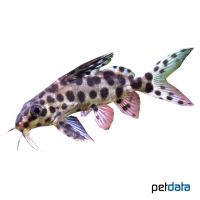Poll's Synodontis (Synodontis polli)
| Poll's Synodontis Synodontis polli | |
|---|---|
| Name | Poll's Synodontis |
| Name Lat. | Synodontis polli |
| Synonym | Synodontis eurystomus |
| Family | Upside-down Catfishes |
| Family lat. | Mochokidae |
| Order | Catfishes |
| Order lat. | Siluriformes |
| Origin | Lake Tanganyika |
| Habitat | Sandy zone |
| Diet | Omnivore |
| pH | 7.5-9.0 |
| Behavior | Peaceful |
| Keeping | Group |
| Care Level | Moderate |
| Reproduction | Egg scatterer |
| Breeding | None reported |
| Life Span | 8-12 years |
| Protection | No |
| Metric Units | |
| Size | 12 cm |
| Temperature | 24-28 °C |
| Hardness | 15-18 °dH |
| Aquarium | 120 l |
| US Units | |
| Size | 4.7" |
| Temperature | 75-82 °F |
| Hardness | 267-320 ppm |
| Aquarium | 30 gal |
Distribution and habitat
Polls featherbeard catfishes are found exclusively (endemically) in Lake Tanganyika, where they are distributed mainly along the coasts to Burundi and the Democratic Republic of Congo as well as to Zambia. They usually occur in shoals and live at greater depths (30-125 m) with sandy-muddy bottoms and only weak daylight.
Maintenance
They require a well-structured aquarium with many hiding places, such as stone caves (e.g. perforated rock, catfish caves) and roots, as well as sufficient swimming space. A dark, soft substrate of fine sand and strongly dimmed light (floating plant cover) is ideal.
No ammonia, ammonium and nitrite should be detectable, the nitrate value should not exceed 100 mg/l. To ensure water quality and oxygen content, a filter and heater adapted to the aquarium size is required, as well as lighting for the species-appropriate day-night rhythm of the animals.
Diet
They are easy to feed and will accept any type of live or frozen food, such as daphnia, cyclops, mysis, artemia and black mosquito larvae, as well as sinking, high-protein dry catfish food (granules, pellets, tablets). Rarely, vegetable food such as algae leaves or dry food with high vegetable content (spirulina, kelp) is accepted
A regular and varied diet promotes health and prevents deficiency symptoms. Only as much should be fed as is eaten in a few minutes.
Behaviour and compatibility
These peaceful fish should be kept in a group of at least 5. They can be well socialized with other fish that are not too small and are not considered food, preferably with cichlids from Lake Tanganyika.
Basically, only compatible fish species with similar demands on water condition and water temperature should be socialized.
Sex dimorphism
The males are more slender than the females. With some experience, the sexes can be determined by the shape of the genital papilla, which is pointed in the male and round in the female.
Reproduction and breeding
There are no known reports of successful breeding in the aquarium.
Important
They are diurnal, but very sensitive to light and therefore only active during the day in well-shaded aquariums. Otherwise they stay hidden in caves or under roots and only come out of their hiding place for feeding
When catching them, use as fine-meshed nets as possible to prevent the hard rays of the pectoral and dorsal fins from becoming entangled, which can cause painful stinging injuries when touched.
The well-being of the fish should be checked regularly. Temperature should be checked daily, pH, hardness and nitrate levels at least every 14 days. Regular partial water changes are recommended, even when contaminant levels have not yet reached the upper limit. Sudden changes in water quality should be avoided. Newly introduced fish must be accustomed slowly to the water in the aquarium.
Further literature can be found in your pet store.
References
Text: Werner Winter; Image: petdata
Source: BMELV (1998): Tierschutzgutachten - Haltung von Zierfischen (Süßwasser); ENGELMANN (2005): Zootierhaltung - Tiere in menschlicher Obhut: Fische, Verlag Harri Deutsch; RIEHL & BAENSCH (2004): Aquarien Atlas Bd. 3, Mergus Verlag
- Gemäß § 21 Abs. 5 Tierschutzgesetz idgF
